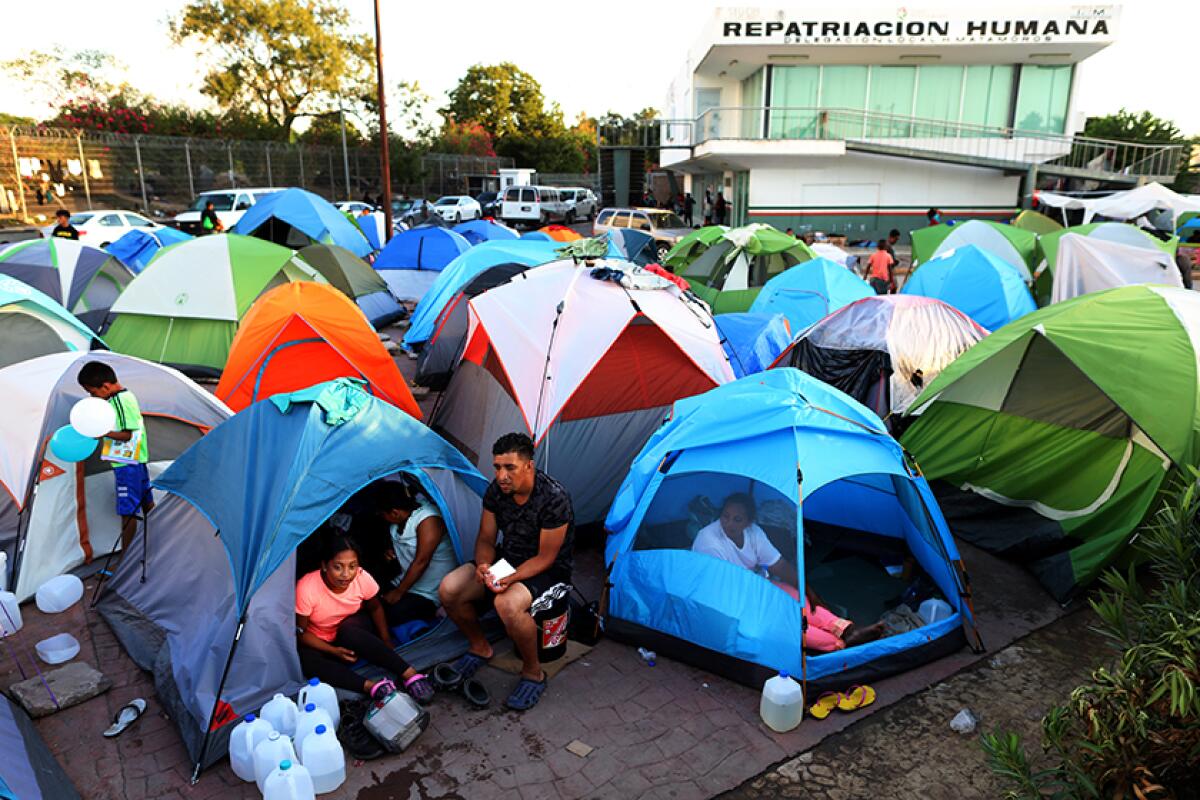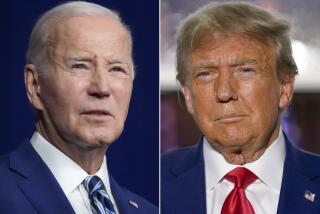Biden administration to start processing ‘Remain in Mexico’ asylum seekers in California

Border officials are set next week to start processing asylum seekers in California and Texas who were forced back across the border under a controversial Trump-era policy that President Biden pledged to end, advocates and officials said Thursday.
U.S. officials will begin next Friday allowing in and processing immigrants at ports of entry in San Ysidro, Calif., and El Paso and Brownsville, Texas, who were subjected to the “Remain in Mexico” policy, shelter directors and United Nations officials told The Times.
Before they are released in the United States, all migrants will be given a medical screening in Mexico, including coronavirus testing, administered by the U.N. migration agency and supported by the United States. Other U.N. agencies also will help process, shelter and transport migrants in Mexico to U.S. ports of entry, working with nongovernmental organizations and shelter networks on both sides of the border, U.N. officials said.
On Biden’s first day in the White House, the Homeland Security Department announced that Remain in Mexico, officially termed the Migrant Protection Protocols, would be paused, not rescinded as he had pledged. Biden administration officials so far have left in limbo an estimated 30,000 migrants stuck at the border under President Trump’s interlocking policies to essentially end legal immigration, including MPP, as they work to identify, review and undo them.
Homeland Security Secretary Alejandro N. Mayorkas said in a statement that the “initial phase” of restarting asylum processing marks “another step in our commitment to reform immigration policies that do not align with our nation’s values,” but he cautioned that at the border, “where capacity constraints remain serious, changes will take time.”
Mexican President Andrés Manuel López Obrador, whose administration cooperated extensively with Trump’s to stop migrants heading north, welcomed the move Friday, saying the Biden administration is committed to “regularizing the situation of migrants.”
“It’s a change in that they will no longer keep migrants waiting for their asylum authorization in our country, but they will have them on U.S. territory waiting,” he said.
Ruben Garcia, executive director of the nonprofit Annunciation House, which has shelters in Ciudad Juárez and across the border in El Paso, said, “Finally we now know what’s going to happen with MPP.”
In recent days Garcia said he has been trying to reassure migrants who have active MPP cases, many of whom have grown frustrated while waiting at shelters in Mexico for the Biden administration to announce its plans.
“There’s still hurdles, but it’s excellent that they’re going to let the families in,” he said, noting that migrants joining relatives in the United States can have their asylum cases heard in nearby courts rather than at the border.
In 2018, Trump administration officials unveiled Remain in Mexico, ultimately pushing upward of 70,000 asylum seekers back to Mexico before the program was essentially frozen last March amid the coronavirus outbreak. Trump officials in effect closed the border, citing COVID-19, and most hearings were indefinitely postponed.
Under U.S. law, migrants at the border have the right to claim asylum, regardless of how they enter. Before Trump took office, asylum seekers and others applying for protection in the United States were generally allowed to wait with family in the U.S. for their hearings. Since, advocates have recorded at least 1,134 instances of kidnapping, rape and assault against migrants sent back to Mexico under MPP.
Under the new administration, U.S. officials will begin by processing the more than 25,000 immigrants under MPP who still have ongoing cases in U.S. immigration courts, prioritizing those who have been waiting longest in some of the world’s most dangerous cities on the Mexico side of the border — some for about two years now — as well as the most vulnerable.
Most are Cubans, Hondurans and Guatemalans, and more than 85% have no attorney, according to Syracuse University’s TRAC database, dramatically reducing their chances.
In “phase one,” officials will build up to processing approximately 300 asylum seekers per day at three ports of entry, Biden administration officials said Thursday, previewing the plans on condition of anonymity without providing a reason.
Biden officials declined to name the ports, or the primary international organization that will be doing the coronavirus testing, both identified by The Times, citing concerns over a rush to the border.
“We don’t want people acting on limited information ... that will not be safe given the current environment,” said one Biden official.
Melissa Flores of Al Otro Lado, a nonprofit that works in Tijuana, said Thursday that her organization and others had been in touch with the administration about border processing, but hadn’t been told where it would begin.
“We’ve started, though, preparing a list of our most vulnerable clients in case it is [Tijuana] and in case they are offering priority to those,” she said.
The Homeland Security Department will provide an online and phone system for migrants in Mexico to put in their U.S. case numbers under MPP and receive instructions “on where to appear, and when,” a U.N. refugee official said on condition of anonymity, not authorized to speak publicly on the plans. Biden administration officials described it as “a virtual registration process that will be accessible from any location.”
The goal is to process the asylum seekers as quickly as possible at the ports of entry, and, rather than send them to U.S. detention centers, enroll them in “alternative detention programs,” under which they’d be swiftly released to family members and their immigration cases could be transferred nearby, administration officials described on a media call.
Chris McGrath, a spokesperson for the U.N. refugee agency, said it is advising both the United States and Mexico on the plans, and will assist “MPP asylum seekers with open immigration cases, to ensure they are aware of the new policy” and can “meet the procedural requirements established by the U.S. government to safely reenter the U.S.”
Biden administration officials stressed that migrants outside the U.S. who do not have pending court cases won’t be allowed to enter, and that those with pending MPP cases already in the U.S. will receive instructions later. Those in Mexico with active MPP cases will only be allowed to enter at scheduled times at designated ports of entry.
“When they hear about this program, some people will move, thinking if they don’t go wherever they need to be they will miss the opportunity,” the U.N. refugee agency official said, expressing concerns about confusion.
Yet thousands of migrants forced back to Mexico under MPP have already given up or were ordered removed in absentia for missing hearings, despite notices to appear in court and other procedures being riddled with errors and misleading information by U.S. officials — or they never received the notices at all. Federal asylum officers and judges have called the policy illegal and immoral.
Among more than 40,000 MPP cases completed or closed, in only 1.5% of cases were asylum seekers granted some form of relief, according to Syracuse’s TRAC.
It is as yet unclear how Biden administration officials will address these asylum seekers, or thousands of others waiting at the border for a chance to make their claims.
“We know that we will start small,” an administration official said Thursday on the media call, adding that they’re starting with those with active MPP cases, “because frankly they are the easiest to identify and process as we start to get this program off the ground.”
The administration has said it will keep in place a Trump-era policy known as Title 42, under which border authorities have turned away hundreds of thousands since March without due process, including unaccompanied children. Officials at the U.S. Centers for Disease Control and Prevention said Trump advisor Stephen Miller and Vice President Mike Pence had pushed the policy for political, not public health, reasons.
“Our position is that health screenings shouldn’t on their own be a prerequisite to enter the United States,” the U.N. refugee agency official said, adding that the U.S. government had decided to keep them in place.
Garcia said that health precautions must be taken by U.S. officials for the migrants’ protection as well.
“We also want to be careful about the intake process so that we do not expose them to picking up the virus,” Garcia said. “Who’s going to be in that room? Are we sure the officers are COVID-free?”
U.S. Customs and Border Protection, which oversees ports of entry, does not test migrants in its custody, instead conducting cursory medical screenings and referring those with symptoms to outside medical providers, officers and agents told The Times. The agency itself has been racked with COVID-19 cases, with 6,778 employees testing positive and 24 dying as a result of the virus.
In recent days, U.S. immigration authorities have separately released several hundred migrants from custody in the United States, a practice that also occurred under the Trump administration. Some community leaders, particularly in south Texas, a region that’s been slammed by COVID-19, have raised alarms.
The Biden administration said that migrants will be allowed to enter the U.S. only under “incredibly narrow and limited circumstances,” and continued to emphasize that they should not come to ports of entry or attempt to cross the border between official entries.
“The vast majority are turned away at the border,” White House Press Secretary Jen Psaki said Thursday. “This is why we continue to convey that this is not the time to come.”
Mexico’s Foreign Ministry reiterated in a statement Friday that “migrants should not go to the border between Mexico and the United States” but await more information.
On Thursday, hundreds of migrants — many with active MPP cases — waited in a fenced tent camp in the Mexican border city of Matamoros, across from Brownsville.
Meanwhile, across the Rio Grande, some migrants who arrived at the border and weren’t put into MPP, but instead crossed the river illegally to Texas and were detained by Border Patrol this week, were released to catch buses and flights to join family.
“We’re all kind of in limbo,” said Mark McDonald, assistant project manager at the camp’s clinic, run by nonprofit Global Response Management, who has been fielding questions from migrants about when and how they will be processed. “We just don’t have the answers.”
More to Read
Start your day right
Sign up for Essential California for news, features and recommendations from the L.A. Times and beyond in your inbox six days a week.
You may occasionally receive promotional content from the Los Angeles Times.








